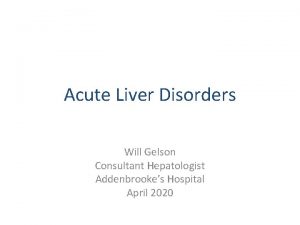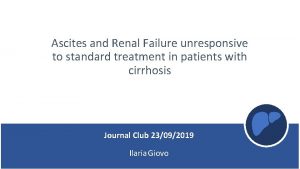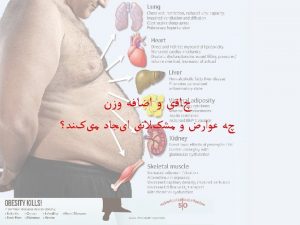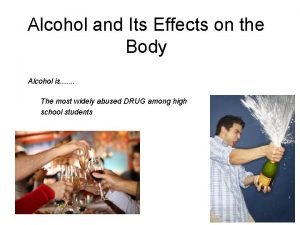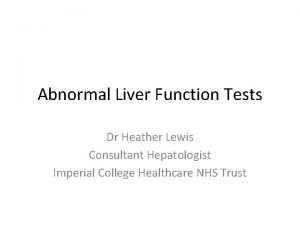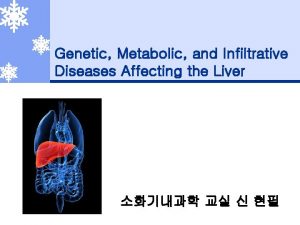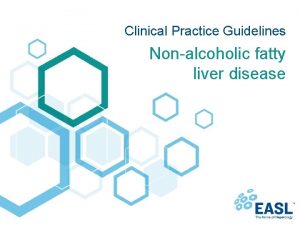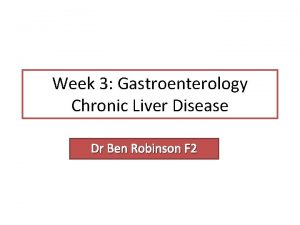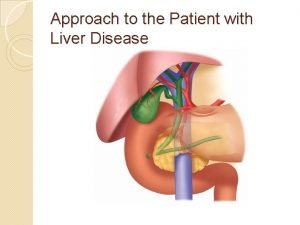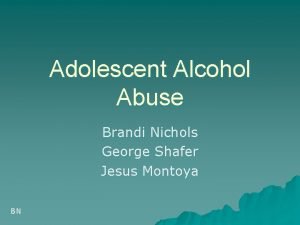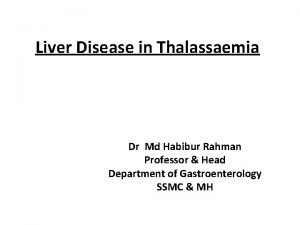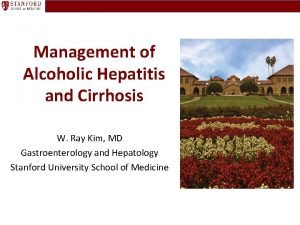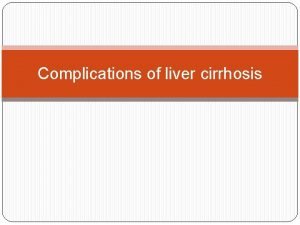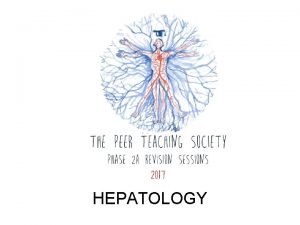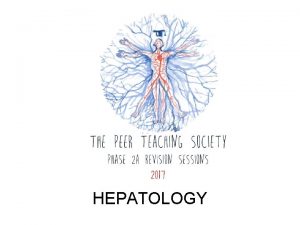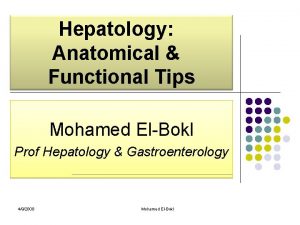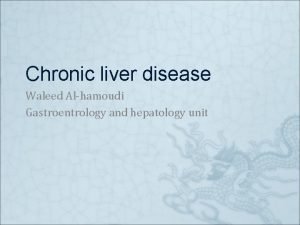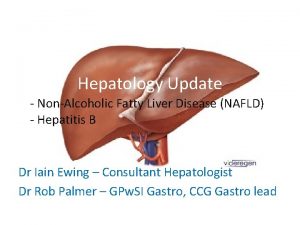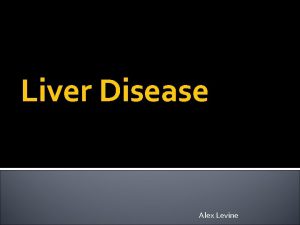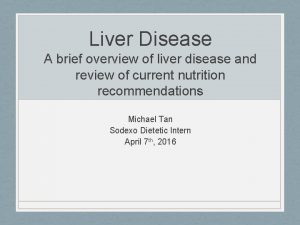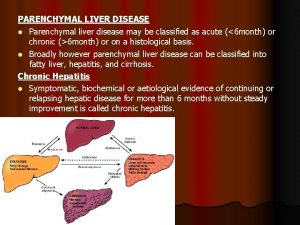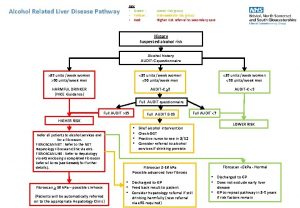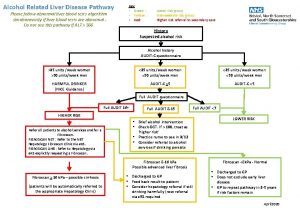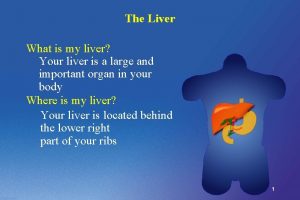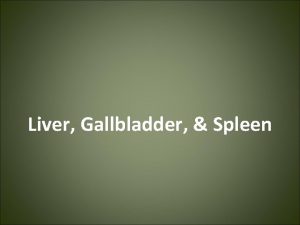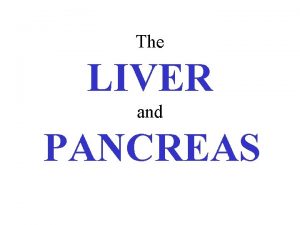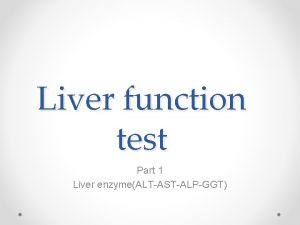Alcohol Related Liver Disease Dr Heather Lewis Hepatology
























- Slides: 24

Alcohol Related Liver Disease Dr Heather Lewis Hepatology Consultant Imperial College Healthcare NHS Trust

Rising mortality from alcohol related liver disease Mortality from liver disease in the UK (Williams et al, The Lancet 2014) Alcohol related liver disease deaths and consumption (ONS and HMRC)

Alcohol related mortality in England by deprivation PHE 2016

Alcohol Related liver disease • Dear Doctor, Re: Deranged LFTs Thank you for seeing this 64 year old patient who was noted to have markedly deranged LFTs on routine bloods done in January for medication monitoring. His ALT had risen to 126, on a background of known fatty liver disease, with normal platelets and albumin. He admitted to drinking one box of wine and a bottle of brandy every week but did not drink daily. He also smokes 20 cigarettes per day. A scan demonstrated diffuse fatty liver and likely alcoholic liver disease. The remainder of his liver screen was unremarkable (see below), however he has just been referred for an urgent OGD in view of dyspeptic symptoms with a slight drop in Hb to 12. 5. His past medical history includes hypertension , high cholesterol and a previous MI. His regular medications are listed below. Thank you for seeing him for further assessment and to consider the need for a fibroscan.

Screening in primary care • AUDIT questionnaire sent to participants • AUDIT > 8 – invited to have STL test in nurse led clinic in GP practice • 24% (1128/4630) AUDIT positive (Sheron et al, 2013)

Results • Normal LFT’s in: • 90% of people with early alcoholrelated fibrosis • 75% of people with severe fibrosis • 75% of 1 st admissions with cirrhosis/ liver failure not seen prev • 78% had AUDIT 8 -15 - hazardous • 22% had AUDIT > 15 – dependent • Fibrosis: • Green – 49% (191/393) • Amber – 40% (157/393) • Red – 11% (45/393) (Sheron et al, 2013)

Transient Elastography for prediction of fibrosis in ALD Fibrosis score TE cut off value Sensitivity Specificity > F 1 5. 9 k. Pa 83% 86% F 2 or above 7. 5 k. Pa 94% 89% F 3 or above 9. 5 k. Pa 92% 68% F 4 12. 5 k. Pa 95% 71% Pavlov et al, Cochrane Database systemic review, 2015

AUDIT and AUDIT-C

AUDIT accuracy in detecting AUD Men (AUROC) Women (AUROC) Cut off AUDIT-C 9 0. 79 0. 82 4 0. 85 Alcohol abuse 10 0. 62 NA 5 0. 65 NA Alcohol dependence 12 0. 77 NA 7 0. 76 NA AUD 10 0. 70 NA 6 0. 73 NA Hazardous drinker Score of > 8 indicates hazardous/ harmful drinking Score of > 16 indicates dependence Foxcroft, DR et al 2015

Alcohol Related Liver Disease

Alcohol-related liver disease algorithm. Philip N Newsome et al. Gut 2018; 67: 6 -19 Copyright © BMJ Publishing Group Ltd & British Society of Gastroenterology. All rights reserved.

Imperial Alcohol Hepatology Service • Dedicated FTE Alcohol Hepatology Specialist Nurse: • • • Fibroscan Extended brief interventions Individual patient support Strong links and referral pathways with community alcohol services Research • Dedicated Alcohol Hepatology clinic • Consultant and Specialist Nurse • Anti-craving medications/ Brief interventions/ Alcohol services referral • St Marys Hospital AA meetings • Alcohol Care team • Representatives from: • ED, CCG, CGL (psychiatrist and clinical lead, and alcohol specialist nurse), Hepatology

Treatment for alcohol dependence • Mainstay of treatment is psychosocial support • NICE recommends use of adjuvant medication in those who have moderate to severe dependence

Brief intervention: • Short session of structured brief advice: • 5 -20 minute counselling session focused on individual • FRAMES – feedback, responsibility, advice, menu of strategies, empathy, self efficacy • Extended brief intervention: • Longer more motivationally-based session • Five As’ model: • Ask about use, Advice to quit or reduce, Assess willingness, Assist to quit or reduce and Arrange follow-up. • Psychotherapy with CBT, peer driven support counselling and motivational enhancement therapy can reduce relapse

Interventions for alcohol dependence Brief interventions for heavy alcohol users admitted to general hospital wards Cochrane Database of Systematic Reviews 10 AUG 2011 DOI: 10. 1002/14651858. CD 005191. pub 3 http: //onlinelibrary. wiley. com/doi/10. 1002/14651858. CD 005191. pub 3/full#CD 005191 -fig-00101

Brief Interventions • Brief interventions (BI) can reduce drinking by 13 -34 % (Whitlock et al) • NNT with BI to reduce alcohol consumption in in person is 8 -12 • 1 in 8 stop or reduce alcohol after brief intervention • Highly cost effective (only taxation was more cost effective) • Reduce drinking by average of 57 g/ week in men • Cochrane review found moderate quality evidence that BI reduces alcohol consumption by approx. 20 g per week compared with no intervention at one year

Acamprosate versus placebo Outcome: Cumulative abstinence duration. Cochrane Database of Systematic Reviews 7 SEP 2010 DOI: 10. 1002/14651858. CD 004332. pub 2 http: //onlinelibrary. wiley. com/doi/10. 1002/14651858. CD 004332. pub 2/full#CD 004332 -fig-0006 Acamprosate versus placebo Outcome: Return to any drinking.

Acamprosate • Mechanism of action unclear • Modulator of glutaminergic receptor system - glutamate antagonist • Not hepatically metabolised • Not specifically tested in patients with advanced liver disease • Well tolerated: • Pharmacovigilance data in 1. 5 million patients showed no SAE’s • Most common AE is diarrhoea • Not addictive, safe in overdose • Contraindicated in severe renal impairment (e. GFR < 30)

• GABA receptor antagonist • Short half life of 4 -6 hours • Minimally metabolised by the liver • Only therapy tested in significant alcohol related liver disease Addolorato et al, Lancet 2007

Baclofen • • • Recommended in EASL guidelines for patients with advanced liver disease Mixed data on efficacy Start at 10 mg tds, titrate up to 30 mg tds Max dose 90 mg in 24 hours Concerns: • CNS depression (esp if relapse to alcohol use or co-prescribed other sedating medication) • May worsen mania • Reduces seizure threshold • Possible increased morbidity/ mortality in high doses

Naltrexone • Opioid receptor antagonist • Reduces return to heavy drinking (NNT = 9) • Hepatic metabolism • Contraindicated in: • Acute hepatitis • Acute or chronic liver failure • Use with caution: • Serum transaminase exceeding 3 x ULN • Renal failure. Cochrane Database of Systematic Reviews 8 DEC 2010 DOI: 10. 1002/14651858. CD 001867. pub 3 http: //onlinelibrary. wiley. com/doi/10. 1002/14651858. CD 001867. pub 3/full#CD 001867 -fig-0005

Outcomes of treatment for alcohol dependence • Over 10 years: • One third continuing alcohol use disorder • One third some improvement • One third good outcome (abstinence or moderate drinking) • 70 -80% of people entering treatment for alcohol dependence relapse • If abstinent for over one year the risk of relapse is low • Age adjusted mortality is 4 x the non-alcohol dependent population

Questions? heather. lewis 4@nhs. net

Non-invasive fibrosis markers in ALD Liver fibrosis markers in alcoholic liver disease, Chrostek et al, 2014
 Addenbrookes hepatology
Addenbrookes hepatology Hepatology
Hepatology Hepatobiliary system
Hepatobiliary system Effects of alcohol on the liver
Effects of alcohol on the liver Effects of alcohol on the liver
Effects of alcohol on the liver Effects of alcohol on the liver
Effects of alcohol on the liver Dr. heather lewis
Dr. heather lewis Dr. heather lewis
Dr. heather lewis Oxidation primary alcohol
Oxidation primary alcohol Primary alcohol vs secondary alcohol
Primary alcohol vs secondary alcohol Portal hypertension signs
Portal hypertension signs Infiltrative liver disease
Infiltrative liver disease Elisabetta bugianesi
Elisabetta bugianesi Decompensated cirrhosis
Decompensated cirrhosis Gastroenterology board review
Gastroenterology board review Stigmata of chronic liver disease
Stigmata of chronic liver disease Dcld vs cld
Dcld vs cld Gennifer shafer liver disease
Gennifer shafer liver disease Stigmata of chronic liver disease
Stigmata of chronic liver disease Stigmata of chronic liver disease
Stigmata of chronic liver disease Cirrhosis
Cirrhosis Complication of liver cirrhosis
Complication of liver cirrhosis 2 types of fitness
2 types of fitness Health related fitness and skill related fitness
Health related fitness and skill related fitness Communicable disease and non communicable disease
Communicable disease and non communicable disease
